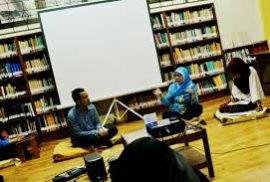Center for Southeast Asian Social Studies Universitas Gadjah Mada successfully held SEA Movie 2017 program titled Borderless On Screen on 8-9 August 2017 in the audio room of Institut Français Indonesia (IFI-LIP), Yogyakarta. The event lasted from 09:00 to 16:00 pm which began with a welcome from Ade Nuriadin, M.A as the program manager of SEA Movie. Furthermore, the program was officially opened by Director of CESASS, Dr.phil. Hermin Indah Wahyuni who hoped that the short films played in the SEA Movie could be a medium that raises awareness to the community in Southeast Asia.
SEA Movie_eng
SEA Movie in cooperation with Minikino held a screening with title “Indonesia Raja: Yogyakarta”. Indonesia Raja itself is a Minikono program in the form of interregional collaboration between regions / cities in Indonesia conducted periodically, 1 (one) time each year in the form of short film program exchange.This year there are several filmmakers from several cities participating in this activity and one of them is Yogyakarta.
The screening (16/08/2016) featured a compilation of four short films. Semalam Anak Kita Pulang (Adi Marsono / 2015), the film with duration of 12 minutes and 41 seconds became the first film of the Indonesian Raja movie series . Adi photographed the reality of life in the current sense that is no longer attractive to the younger generation of job seekers. Through the mother who missed her daughter, this film shows the anxiety of a mother who can not meet her child, even her only daughter went to another place (city) to try her fortune. Nilep (Wahyu Agung Prasetyo/ 2015), tried to play “good” and “bad” from the perspective of children, which leads to the notion that, presumably, these two perceptions are still childish in the context of Indonesian society. Sasi Takon (Wawan Sumarmo / 2015), a short film that tells the story of the impact of taboos that are violated and it causes unrest that arises from a child’s question to his mother. This film records the social conditions of society through different sides. The fourth film, Bawang Kembar (Gangsar / 2015) is an animation film with a duration of 18 minutes. The interesting thing about this film is its use of mythical figure of Javanese as well as moral values and goodness that comes from even a figure who is considered evil .
How far do we know our neighbors? Neighbors are probably the closest people who actually keep the enigma and do not prejudice. But, cinema can help you uncover our nearest neighbor’s curtain: Malaysia. There are five movie options that can be your window to peek our neighbors Malaysia. Sepas made by Yasmin Ahmad reveals intricate interethnic relations in Malaysia. Meanwhile, Ho Yuhang through Rain Dog climbs the dark alley of ethnic Chinese conditions in Malaysia. Similarly, Songlap made by duo Effendy Mazlan and Fariza Azlina Isahak unmistakably reveals the other side of the sparkling capital of Kuala Lumpur. By contrast, Dain Iskandar Said via Bunohan brings you to recognize the face of Malaysia’s peripheral that is not less complicated. And, lastly, Mamat Khalid invites you to taste the taste of classic Malay cinema wrapped in ‘noir movie’ style in the Kala Bulan Mengambang which is loaded with contemporary Malaysian political allegories. So, watch the Malaysian cinema and seize the opportunity to recognize it. (Budi Irawanto)
The afternoon was overcast and a moment later it was raining heavily. In the not-so-extensive library room, a group of audiences had sat sweet and relaxed, waiting for Anthony Chen’s Ilo-Ilo to be screened. This 100 minute movie, apart from the numerous awards it earns, is worth talking about. The film itself is set in 1997, which we know at that time countries in the Asian region experienced a terrible economic crisis. The economy is paralyzed, unemployment everywhere, and Ilo-Ilo recording all of it through the simple relations of the employer and the maid, binding his characters in socio-economic relationships which then changing meaning over time, into a strong psychological relationship.




